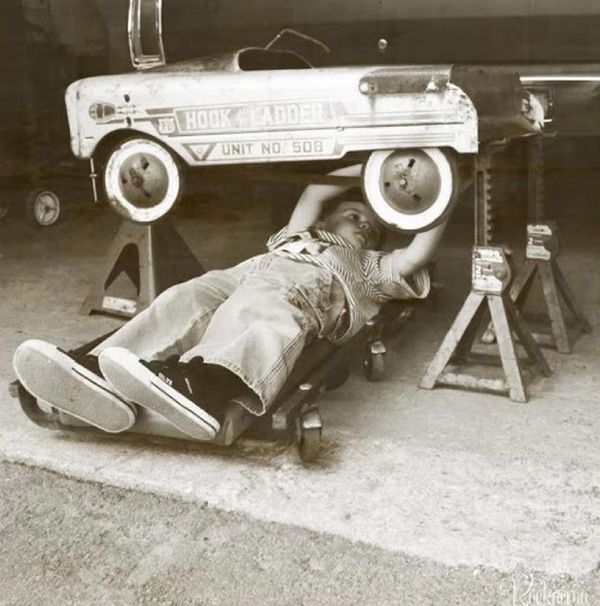11 Important Things Every Car Owner Should Know
- Category: Pics |
- 7 Feb, 2020 |
- Views: 3739 |

Whether it's a brand-new Honda or a classic Ford Mustang from Revology Cars Shop, buying a car nowadays is so easy. Learning how to drive is easy, too. But then, let's face it. It's so difficult to know everything about cars. Still, as a wise car owner, basic user of automobiles, or even an enthusiast, there are certain things you should know to do and how they work. Of course, you should also know how to keep your car in tip-top condition. No excuses.
Let's begin with the basics, and then proceed to more advanced levels, shall we?
1. Maintenance schedule
If you really want your car to be in great shape and to keep running well, sticking to its maintenance schedule is your best bet. Your schedule will tell you when to rotate the tires, when to check the fluids, and when to change the oil. Every car has its specific maintenance schedule, which has to be followed to maintain optimal health, performance, and longevity. Carefully read and follow the recommendations in your car's manual for checking and replacing fluids and car parts. That should be easy, right?
2. Car engine oil
Contrary to what many people think, car engine oil isn't there to help burn fuel, but rather, to:
• Lubricate the engine: The engine has so many moving parts, and if not well-lubricated, they will create heat, and the engine will wear down.
• Cool engine components: Without proper lubrication, there will be a lot of friction, which will, in turn, lead to a lot of heat. Maintaining clean and recommended oil levels prevents friction and overheating.
• Improve gas mileage: A poorly lubricated engine consumes more fuel.
• Remove sludge and engine wear particles: Dirt particles are harmful to the engine. In the long run, these particles cause corrosion. Also, oil changes to sludge over time. Changing the oil and filters helps to keep the engine clean by removing dirt particles and sludge.
• Promote vehicle longevity: It goes without saying - routine maintenance increases the life of a car.
You should be able to change your car engine oil. Well, it isn't a requirement that you change your car engine oil every time, but come on, you should at least be able to change it. It isn't that difficult. Grab a cheap pair or ramps and do it yourself.
3. Read a dipstick.
Normally, a dipstick is used to check whether the car has enough or excess oil in it. However, a dipstick can tell you the state of the oil, and how well or bad the car is maintained. For instance, if you're purchasing a used car and you find grit on the oil that's on the dipstick, walk away.
4. Year, make, and model
The first thing you should probably know about your vehicle is the year of manufacture, the make, and the model. It may seem like a no-brainer, but you'd be amazed by the number of people who don't know all this information. Many people are sometimes mistaken about the year of manufacture or the model, which can result in major mistakes.
Parts, fluids, and accessories to repair and maintain the car are based on the year of manufacture, the make, and the specific model. Knowing the exact information is, thus, very important. Models, construction, and design can significantly change in a year, and so will the parts required for your vehicle.
5. VIN
Although you need not memorize it, you should know where to find your Vehicle Identification Number (VIN). It's your vehicle's fingerprint. VIN identifies your car's make, model, engine size, year of manufacture, place of manufacture, engine size, etc. It stays with your vehicle throughout its life. VIN is located where the dashboard and the windshield meet. VIN is useful when buying spare parts, buying a car, and talking to a mechanic or insurance companies.
6. Engine light
Imagine driving home from work, and suddenly, the 'Check Engine Light' comes on. It pops on without any warning and provides no explanation. What do you do? You see, ‘Check Engine Light’ is one of the most confusing and frustrating warnings - just a light without further information, so you can't know what the problem is.
There are many possible reasons, but the most important thing is to check whether the light is blinking or steady. If it's blinking, pull over and call for help. If the light is steady, there's no immediate cause for alarm, but you still need it to be checked by a professional. You can schedule an appointment with a mechanic later that day or in a few days.
Common reasons why the check engine light pops on include:
• A faulty or loose gas cap
• The oxygen sensor needs replacing.
• The catalytic converter needs replacing.
• You need a new mass air flow sensor.
• New spark plugs and wires may be necessary.
7. Tire pressure
Tire pressure is probably the most assumed car maintenance concern. Many people think it's not a big deal, but they are so mistaken. Tire pressure is a vital safety feature on a vehicle. When tire pressure is too low, too much of the tire's surface touches the ground, which increases the friction between the ground and the tire. Your tires won't only wear prematurely, but they will also overheat, which could cause tread separation, and that's an accident waiting to happen.
Conversely, too much tire pressure isn’t good. When tire pressure is too high, much less tire surface touches the ground. As a result, the vehicle will bounce around on the road, and it will be a bumpy ride for everyone. It also results in less traction, and your stopping distances suffer. You can easily misjudge an area when applying the brakes.
8. Spare tire
The spare tire isn't designed to add frivolous decoration to your car. It's there in case one of your tires goes flat. Ensure you familiarize yourself with where it's located (including the jack and other tools), so you don't have to look for anything necessary to change a flat tire when you need to.
Ensure your spare tire is always inflated. Imagine wanting to change your flat tire, but realize your spare tire is as flat as a pancake as well. It would surely suck, wouldn't it?
Every car owner should know how to jack up their car and change the tire. Changing a tire is easy. Although run-flat tires are becoming increasingly popular, it shouldn't be an excuse not to know how to change a tire.
9. Torque your lug nuts.
Every car owner should know how to torque their lug nuts and do it properly. Lug nuts shouldn't be too loose or too tight. When lug nuts are too loose, the wheels could come off when you're driving, putting you in great danger. If the nuts are too tight, they can damage break fasteners, bolt threads, or warp new rotors. Use a wrench to get them to your manufacturer's specification - no more, no less.
10. Jumpstart your car.
Trouble happens. You probably left your car lights on, and now, your battery is dead, and the car can't start. Fortunately, you're a well-prepared driver and always carry emergency equipment with you, including jumper cables. Unfortunately, you're one of the many drivers who learn basic car maintenance, but fail to learn how to jumpstart their car. You're standing there, wondering how the alligator-mouthed clips will raise your battery from the dead. But then, look, it isn't that difficult.
With jumper cables and a power source (could be another car or a portable jumper battery), you're good to go.
Follow these steps to jumpstart your car:
• Turn off both vehicles.
• Attach alligator clips as follows - connect one end of the positive (red) jumper cable to the positive terminal of the dead battery. Connect the second positive end to the positive terminal of the donor battery. Connect the black (negative) clip to the negative terminal of the good battery. Finally, connect the other black clip to a clean, unpainted metal part of the dead car.
• Start the donor car to supply power to the dead battery. Keep it running for about 3 minutes before you start the dead car.
• Remove the jumper cables in reverse order.
• Keep the jumped car running to give the battery enough time to recharge.
Is that too difficult to do? Perhaps not, but you can wait a few hours for AAA to send somebody!
11. Change a spark plug.
Every car has spark plugs. Well, unless it's 100% electric. Although modern spark plugs last longer compared to spark plugs in the olden days, they still need to be replaced. This exercise shouldn't take you more than an hour and will save more than one hundred bucks in labor. Head to YouTube and find someone replacing their plugs in a vehicle just like yours.

